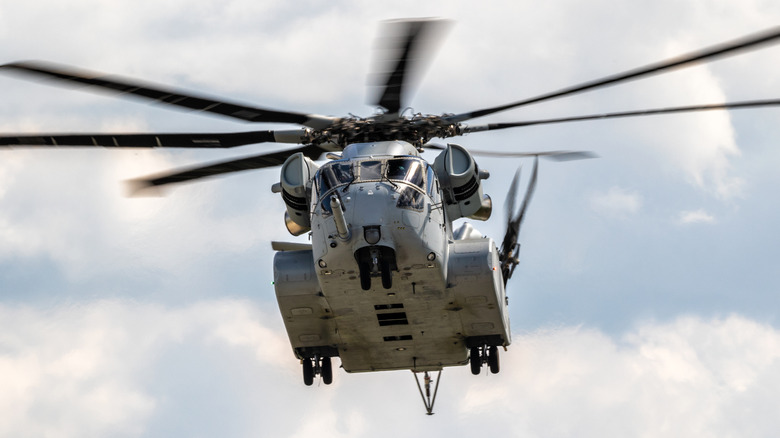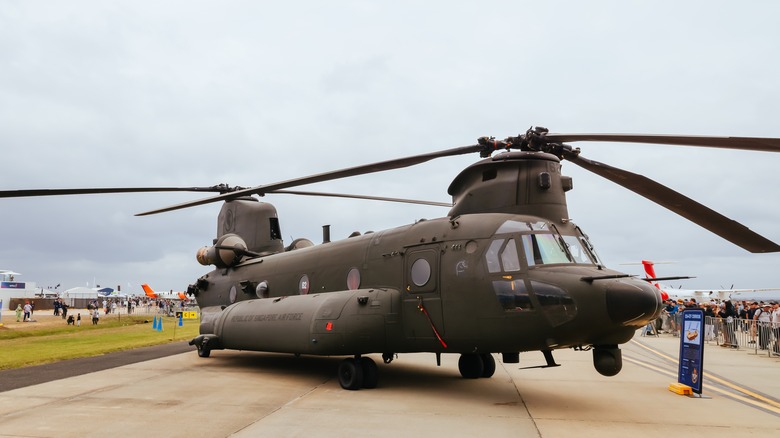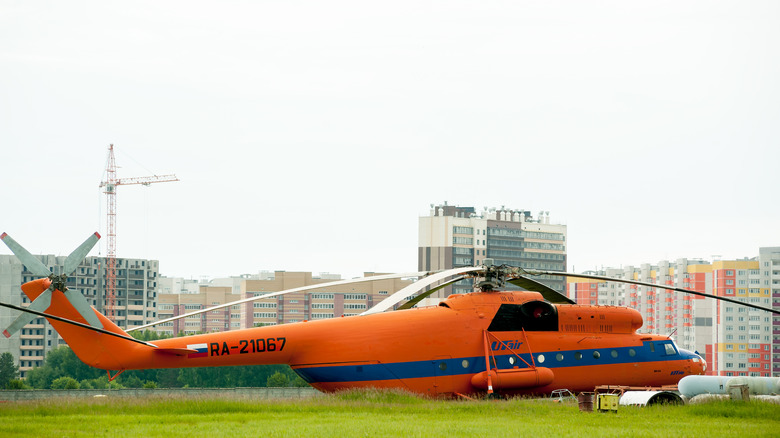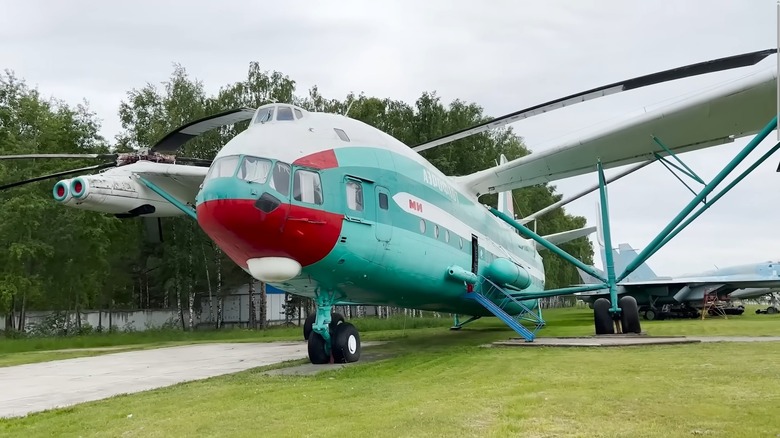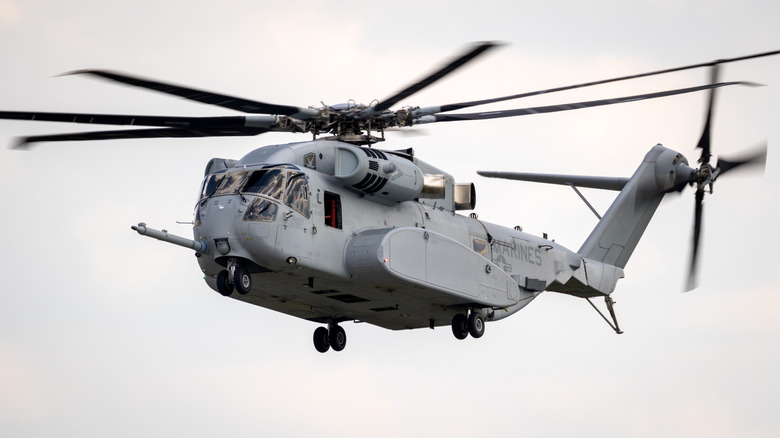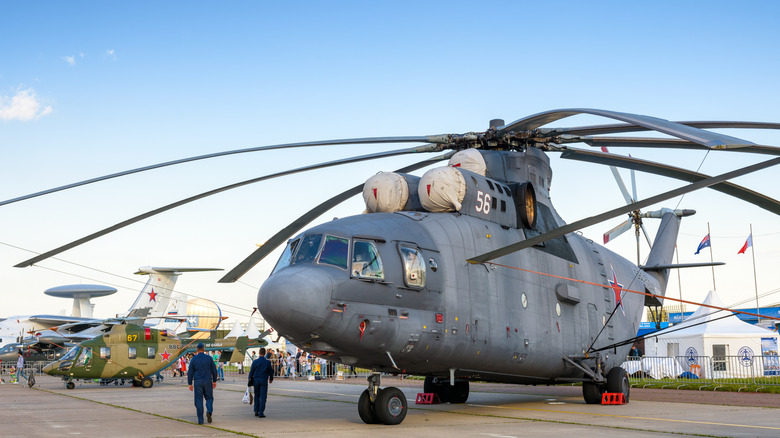5 Helicopters With The Most Powerful Engines To Ever Hit The Skies
If there's one common trait shared by most helicopters, it's that they're light. And that's because it takes far less energy to lift something that's lighter, so the most efficient designs are often on the smaller side. But what if your requirements extend beyond that — let's say you need to transport an APC, 24 medical litters, a platoon of fully-equipped soldiers, a massive air-conditioning unit for a skyscraper, that sort of thing. In those cases, you want pure, undiluted power. And nothing is more powerful in the realm of rotary-wing aircraft than these.
We'll discuss the most powerful engines ever fitted to these monstrous helicopters, as well as the basics behind each platform. The main criteria for this list are that the aircraft features a conventional or tandem rotary-wing design, no tilt-rotors. So that rules out the V-22 Osprey, though if you're curious as to where that'd be on the list, an Osprey sports two Rolls-Royce AE1107C engines producing 6,150 shaft horsepower each — making it number four.
The final criteria are that this addresses only one engine's power. All of the aircraft on this list feature at least two turbine-powered engines, but all ratings given reflects only one engine's rating, given in shaft horsepower. Soviet aircraft list their specifications in metric kilowatts; in those cases, the units of measurement are converted. So for a helicopter's total power output, multiply the horsepower rating by the number of engines on-board.
Boeing CH-47F Chinook Block II – 2x Honeywell T55-GA-714A – 4,777 horsepower each
The CH-47F has a long American legacy, and that's very much by design — due to the advantages of its tandem-rotor system, this helicopter channels virtually all of its power into lift. It's a design dating back to the very first helicopters to ever take flight, such as the Focke-Wulf Fw-61. In the late-1940s, Piasecki produced the H-21 Workhorse, perfecting the fore-aft tandem-rotor configuration, which served as the ancestor to the H-47. It's certainly one of the strangest helicopters in-service, but also an incredibly storied one.
With a service history dating back to 1962, the H-47 lineup naturally saw multiple iterative improvements over the years, with modern aircraft in-service featuring modernized avionics, equipment, and decades' worth of optimization and development. Surprisingly, it's not even the oldest aircraft on this list, though it's certainly among the most influential American transport helicopters. To date, the Chinook saw service throughout multiple conflicts dating back to Vietnam, with original units able to carry up to 8,000 pounds, or 10,000 pounds with a CH-47B.
A modern CH-47F features brand-new engines, so it's even more capable than that. With a total of over 9,000 shaft horsepower, a CH-47F is rated to carry up to 27,700 pounds of useful load. It's one of several variants in service with 20 countries, making it among the most ubiquitous military rotary-wing aircraft today. That said, its design continues being iterated upon, with the latest evolution being updated engines. The next-generation powerplants slated for this aircraft, the Honeywell T55-GA-714C, purportedly boasts some 6,000 horsepower and higher fuel efficiency with only minor modifications needed.
Mil Mi-6 – 2x Soloviev D-25V, 5,500 horsepower each
While not particularly well-known on this side of the Iron Curtain, the Soloviev D-25V (the "V" standing for "Helicopter" in Russian) represents the backbone of early airlift powerplants. And the aircraft which debuted this engine sits comfortably ahead of the Chinook despite being an older design — the Mil Mi-6 Hook. First taking flight in 1957, the Hook became the largest helicopter to take flight at that time –- though it was a shortly-lived mantle, with two further developments comfortably dethroning it, but more on those later.
The muscular D-25V powerplants propelled the aircraft into the record books on more than one count. Aside from being the largest helicopter, it was also the fastest, being the first to break the 300 km/h (187 mph) barrier. On August 26, 1964, it reached an absolute top speed of 340.15 km/h (211.35 mph), though its usual top speed was around 180 mph. In addition to a crew complement of six, the Hook could carry a hefty payload of up to 90 troops, basically a small company of service members and equipment.
These helicopters were built until 1981, serving with Aeroflot and the Soviet Air Forces for decades. Their principle design criteria called for mainly logistics transport, moving goods such as large trucks, heavy equipment, and other loads considered too awkward or bulky for conventional transit. And it excelled at this role, thanks to its internal payload capacity of over 26,400 pounds.
Mil V-12 – 4x Soloviev D-25VF, 6,500 horsepower each
This marks the only prototype aircraft on this list –- and what a prototype it is. The Mil V-12 took to the skies in July 1968, not so much soaring as it slowly lumbered its way into the record books. This is, without argument, the largest rotary-wing vehicle to ever achieve sustained, controlled flight. An easy way to picture this is to take a modern jet airliner, chop the wings off, and replace them with two 35-meter five-bladed rotors (identical to the Mi-6) on sponsons. Each sponson housed a pair of D-25VF powerplants, an evolution of the D-25V on the Mi-6, producing an additional 1,000 shaft horsepower each. This also makes this the most powerful helicopter ever built, producing a total of 26,000 shaft horsepower.
It's difficult to understate just how ludicrous this machine truly is. Dimensionally, it's about as long as a modern Boeing 737 and has a staggering maximum takeoff weight of 231,485 pounds. Plus, it can fit up to 196 passengers in an incredibly spacious cargo area, thanks to the mechanical components fitted on the wingtips. In other words, this is a rotary-wing aircraft that offers fixed-wing levels of capacity.
It's not quite on-par with the largest fixed-wing cargo aircraft ever made, but it's simply on another level versus any other helicopter. For instance, the V-12 weighs more than twice as much as the second-largest helicopter ever made, the Mil Mi-26. It was principally designed to carry heavy cargo like ballistic missiles to remote locations. Sadly, this utter mockery of the laws of physics never entered series-production, though two prototypes survive to this day.
Sikorsky CH-53K King Stallion – 3x General Electric T408 GE-400, 7,332 horsepower each
The CH-53K King Stallion is by far the most modern helicopter on this list, with its maiden flight taking place on October 27, 2015. Its design philosophy principally calls for operational diversity — that is, transporting multiple types of cargo in a single trip, such as 32 soldiers in crash-rated seats with equipment or light vehicles strapped in-between. It also features more specialized and advanced equipment such as quick-release cargo modules, 24 stacked medical litters, invertible cargo rollers, and more. While it certainly won't out-haul a Mil V-12, it still carries a respectable 27,000-pound typical cargo capacity, more than adequate for the U.S. Navy and Marines.
Equipped with three General Electric T408 turbine engines, the King Stallion also marks the third most powerful rotary aircraft on this list, and easily the most powerful in the United States arsenal. The CH-53K even dwarfs the Chinook's figures utilizing its upcoming 6,000-horsepower Honeywell T55-714C upgrade, measuring 12,000 combined shaft horsepower. The King Stallion, meanwhile, boasts three 7,332-horsepower GE T408 engines that produce a whopping 21,996 combined shaft horsepower.
So not only is it among the most iconic military helicopters, but also lists as one of the most powerful platforms overall. Thanks to its relatively small shipboard footprint and cargo capacity nearly triple that of a CH-53E, the King Stallion quickly became a favorite of the Navy and Marine Corps, with 200 ordered for the USMC alone in 2023.
Mil Mi-26 – 2x Lotarev D-136, 11,400 horsepower each
The Mil Mi-26 "Halo" marks the final say in terms of sheer horsepower, producing a staggering 22,800 combined shaft horsepower from two massive Lotarev D-136 turboshafts. Despite its first flight happening way back on December 14, 1977, no other rotorcraft has since produced comparable numbers in terms of payload capacity or raw power (at least from a dual-engine configuration). It holds numerous world records (discounting the V-12, obviously), including the most payload ever lifted by a series-production rotorcraft and several payload-to-altitude records.
The reasons why it can carry so much rely on two factors: the first, fairly obviously, is the sheer, brute power of the engines. The second is the design of the 32-meter main rotor, which is actually smaller than the preceding Mi-6's rotor. However, whereas the Mi-6 only has five blades, the Mi-26 features a total of eight blades. It was actually the first series-production aircraft with such a rotor design — which, coupled with a single engine being more powerful than the Mi-6's combined output, could carry all but the heaviest of loads across vast distances.
The main reason why the USSR employed such massive rotorcraft was simple: it's a massive place, and there's not always an available airfield in the far-flung corners of Russia. It's often mountainous or snowy, with huge distances between civilized areas. So transport by aircraft like these proved especially useful when building isolated military structures and complexes, with these helicopters able to transport goods such as trucks, ordnance, and personnel between locations without the need for complex rail infrastructure.
